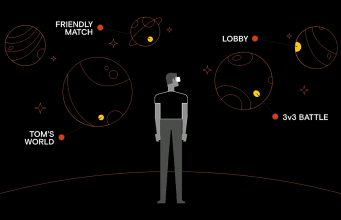
Social and Multiplayer VR can be incredibly compelling, but the process of actually ‘finding’ your friends in VR is still a clunky and often frustrating process. Oculus is developing a new set of social and multiplayer tools which stand to make it much easier to directly connect with friends by treating games and apps more like actual places.
When it comes to social VR experiences today, if you want to meet up with a specific person to play a game, watch a movie, or hang out, the process often involves using a communication channel outside of your headset (like a messaging app) and setting a time to put on your headset and which specific game you will launch and join. If all goes smoothly, you join each other in a lobby and then launch into whichever activity you planned to do.
However, things often don’t go smoothly—a friend is late, they aren’t joinable, or you had some miscommunication about where to meet—which often means your headset comes off, your phone comes out, and you need to continue to communicate through that other channel to figure out what’s going on. Then you have to dive back into your headset and find each other again.
This clunkiness is the result of three major factors: 1) poor means of communication between those inside of a headset and those outside, 2) VR games leaning on the same multiplayer paradigms of non-VR games, which usually means not being able to join your friends in a game unless they are in a designated state/location within the game (like a lobby), and 3) difficulty discerning ‘where’ friends are within an app, and how and when they might be available to join.
Oculus is releasing new social tools in an effort to make this process much more smooth. If developers adopt the tools, the platform stands to make VR feel more like a ‘place’—where you navigate to friends no matter where they are—rather than the current feeling of each social app being its own opaque island.
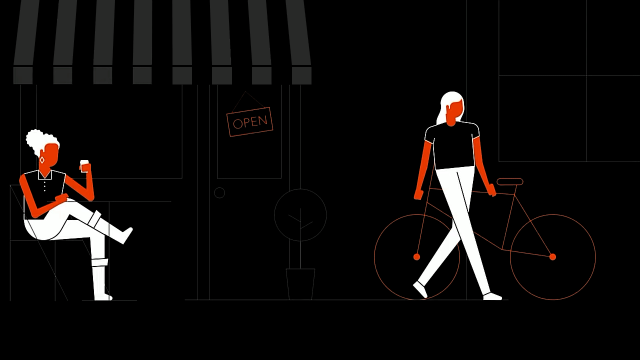
On stage at Oculus Connect 6 at the end of September, Oculus’ Mike Howard, Product Manager for Platform SDK and Avatar SDK, laid out the goals for the new social tools.
“We want people to be able to browse for things to do in VR with others ahead of time, make it easy to get in touch with friends, coordinate, communicate, share what they’re going to do, share their intent to be social with each other head of time,” Howard said. “And ultimately when you’re in [VR], when you’re moving between those different social contexts, [we want it to] feel seamless and very frictionless so that you can I can just explore VR together instead of navigating all of the challenges of getting to the right place.”
He also spoke to the ‘place’ paradigm, and how the current state of social VR is counterintuitive compared to how people meet and socialize in the real world.
[…] if we plan to meet in the real world, I would tell you ‘we should meet here in San Jose, I know a great coffee shop just down the road […] we could grab a table for four this weekend’. I might even send you a message with a link on a map that told you exactly where you needed to go. Doing the same thing in VR today is like me saying ‘hey let’s meet somewhere in San Jose in America’—not the most detailed description of where we’re going to be. There’s no link, there’s no map, that takes you to exactly where I’m going to be.
And that’s because our view of the platform as we think about it today is, for the most part, opaque to us what’s going on inside each one of the apps on the platform. We want to create a much more complete picture of all of these amazing worlds and places in our ecosystem. It’s a rich layer of meta-data that, if we know about it, we can use to let people know where they can go and allow people to share what they’re doing with much more context, and think about getting [to specific locations within VR] ahead of time. Once we have that meta-data, we’re very capable of building the technologies that enable people to travel between experiences […].
In order to achieve this, Oculus’ social tools will soon integrate three new features: Destinations, Deep Linking, and Rich Presence.
Destinations
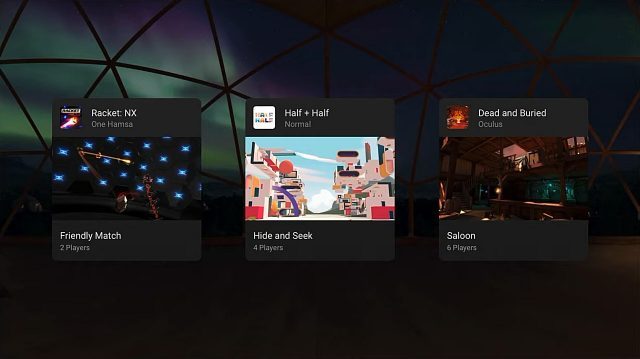
Destinations, Howard explained, are developer-defined virtual places within apps. This could be a game level, a public area, a private lobby, or even an active match. Defining part of an app as a Destination marks it as a specific ‘place’ and lays the groundwork for taking users directly to that place within the app. You can think of this a bit like how each webpage has its own address (the URL) which defines ‘where’ a user is on the site. So instead of asking you to go to RoadtoVR.com and then manually navigate to a specific article, it’s possible instead to point you directly to a specific page by giving you a more specific address.
Deep Linking
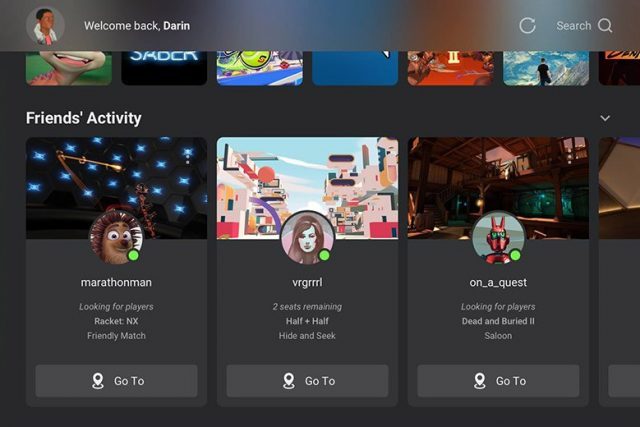
Indeed, links aren’t just a metaphor, they’re actually a major part of Oculus’ approach to sharing ‘places’ within VR apps, through so-called Deep Linking. If a developer defines part of their app as a Destination, they can use a Deep Link to take users directly to that place even from outside the app or outside of VR itself. Deep Links are literally URLs, which means they can be shared just as easily as a website link.
Howard explained how this will work—let’s say I just tried a new song in Beat Saber and wanted my friend to try it out. I could text them a Deep Link to the song; when they click the link, the Oculus mobile app will launch on their phone and ask which headset they’d like to launch the link on. After putting on their headset they’d be prompted to continue to the Destination, which would launch the app and take them directly to the song I shared with them.
Deep Linking opens lots of possibilities, and developers could get even more creative with it. Let’s say I wanted to show my friend a secret I found in Asgard’s Wrath. It would be possible to not only specify a Deep Link to a specific level, but the link could even include the specific coordinates where I was standing in the game, allowing my friend to appear right next to the secret. This would cut out a tremendous amount of additional work to get them to that ‘place’ (launching the game, selecting the correct level, then virtually walking/navigating to the location based on verbal instructions).
Deep Links can also be used to bring players to your current destination, making it easy to get into the same lobby, room, or match together.
Rich Presence
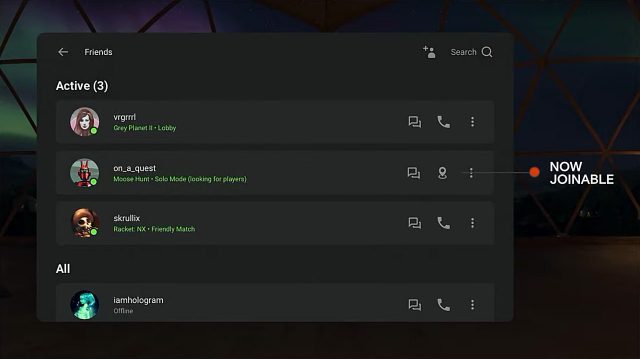
Rich Presence is a foundation for providing cross-app context to players so that the state of their friends is more clear. While many apps will continue to allow friends to join you only when you’re in a ‘joinable’ space, Rich Presence can help friends understand if you’re joinable, or if you will be soon.
For instance, Howard said, an app could relay to the Oculus platform that you’re in a single-player match but currently looking for friends to join. This information would be visible to friends in their Oculus friends list so that they know you’re joinable. Alternatively if you had already started a match, the app could show that your match has two minutes remaining; this makes it easier for friends to see that you might be available soon for an activity.
– – — – –
It’s easy to see how turning parts of apps into uniquely identifiable places, making deep links which can be shared outside of VR but functions as entry ways into VR, and the context added through Rich Presence will go a long way toward breaking down the current sense of isolation between VR apps. Oculus is also planning a messaging feature which will allow users to communicate seamlessly from inside and outside of VR.
In theory, it’s a big step forward for making traversal within VR much easier, but there’s a catch. By their nature, social and multiplayer VR apps would ideally like to connect their users across all platforms, it seems like Oculus’ new social tools will only be applicable to apps on their platform. That makes things complicated for developers building social VR apps and releasing them on other platforms like Steam, Viveport and PSVR.
The lack of cross-platform capability was an often cited reason why few developers chose to pick up Oculus’ otherwise excellent avatar system. Eventually Oculus took this feedback and made their Avatar SDK available outside of their platform. The new social tools, for that matter, are closely tied to the Oculus platform; while it’s understandable why they’ve architected it to be platform-dependent, this may hamper adoption just as we saw with the Avatar SDK.
The post New Oculus Social Tools Will Help VR Feel More Like a Place, Less Like a Game appeared first on Road to VR.
Ream more: https://www.roadtovr.com/oculus-social-tools-help-vr-feel-more-like-a-place/
No comments:
Post a Comment